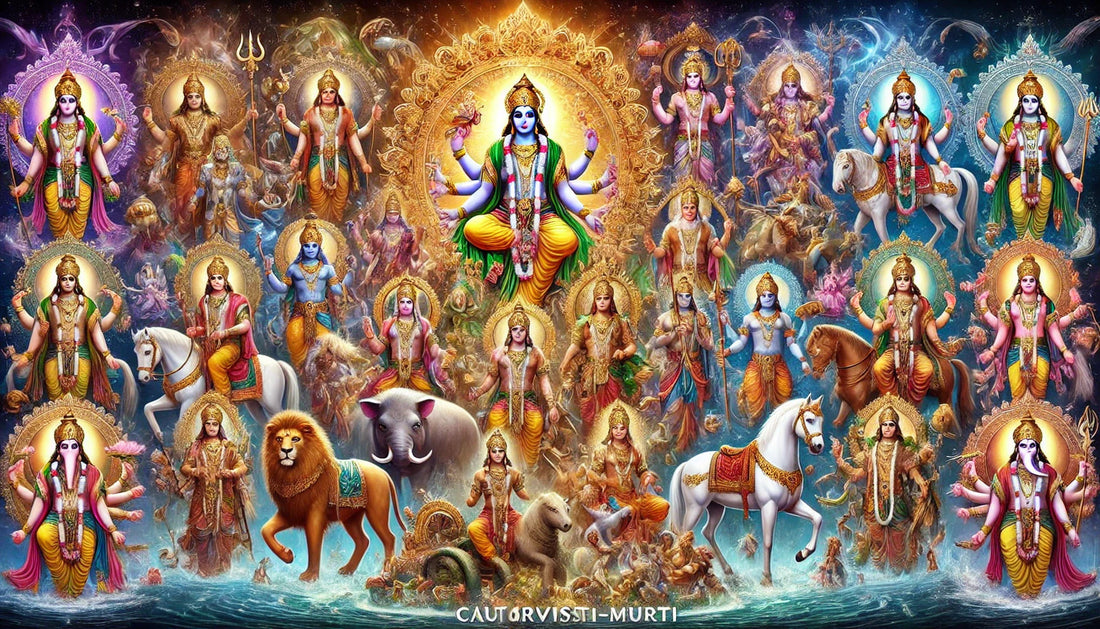
The 24 Forms of Vishnu: Exploring the Caturvimsati-Murti
Share
Vishnu, one of the principal deities of Hinduism, is known for his multiple divine forms that manifest to restore cosmic balance and protect the universe. Among these forms, the Caturvimsati-Murti or the "24 Forms of Vishnu" holds a significant place in Hindu theology. These 24 manifestations of Vishnu are revered for their diverse aspects, each embodying unique qualities that cater to specific cosmic needs. In this blog, we will explore the meaning and significance of each form and their impact on Hindu culture and worship.
What is Caturvimsati-Murti?
The term "Caturvimsati" translates to "twenty-four" in Sanskrit, and "Murti" refers to an iconic form or image of a deity. The Caturvimsati-Murti, therefore, represents the twenty-four distinct forms or avatars of Lord Vishnu. These forms collectively showcase Vishnu's ability to adapt to different situations and restore balance in the universe. These 24 forms include both well-known incarnations, such as his ten famous avatars (Dashavatara), as well as other lesser-known ones.
The 24 Forms of Vishnu: A Breakdown
The 24 forms of Vishnu are described in various sacred texts, including the Puranas. These forms are categorized according to their roles, qualities, and the purposes they serve in preserving dharma (cosmic order). Let’s take a closer look at these 24 divine manifestations.
1. Matsya (The Fish)
Matsya, the first form of Vishnu, is depicted as a fish. In this avatar, Vishnu saved the ancient scriptures and the sage Manu from a great deluge, symbolizing protection and preservation of knowledge.
2. Kurma (The Tortoise)
As Kurma, Vishnu took the form of a tortoise to support Mount Mandara during the churning of the ocean (Samudra Manthan), where the gods and demons sought to obtain the nectar of immortality.
3. Varaha (The Boar)
Varaha, the boar, is known for rescuing the Earth, which had been submerged in the cosmic ocean by the demon Hiranyaksha. Vishnu lifted the Earth from the ocean, symbolizing the restoration of the planet's order.
4. Narasimha (The Man-Lion)
Narasimha, the half-man and half-lion form, appeared to defeat the demon king Hiranyakashipu, who could not be killed by man or beast, indoors or outdoors. This form represents divine justice and the protection of devotees.
5. Vamana (The Dwarf)
Vamana, the dwarf Brahmin, subdued the demon king Bali. He asked for three paces of land and then expanded in size, covering the entire universe in three steps. This form symbolizes humility and divine authority.
6. Parashurama (The Warrior with an Axe)
Parashurama, the Brahmin warrior, was a fierce avatar who rid the world of corrupt rulers and tyrants. His axe symbolizes the destruction of evil.
7. Rama (The Prince of Ayodhya)
Rama, the seventh avatar, is one of the most celebrated incarnations of Vishnu. He is the hero of the Ramayana, known for his idealism, dharma, and his quest to rescue his wife, Sita, from the demon king Ravana.
8. Krishna (The Divine Flute Player)
Krishna, the eighth avatar, is one of the most popular and beloved forms of Vishnu. He is depicted as a mischievous child, a passionate lover, and a wise teacher. Krishna’s teachings in the Bhagavad Gita are central to Hindu philosophy.
9. Buddha (The Enlightened One)
Some traditions include Buddha as an avatar of Vishnu, where he is believed to have incarnated to guide humanity toward enlightenment and compassion.
10. Kalki (The Future Avatara)
Kalki, the future avatar, is predicted to appear at the end of the current age (Kali Yuga) to rid the world of corruption and restore justice.
11-24: The Lesser-Known Forms
In addition to the famous ten avatars, the Caturvimsati-Murti includes several other forms of Vishnu, which vary across different texts and interpretations. These lesser-known forms represent various qualities of Vishnu's divine roles:
-
Aja (The Unborn)
-
Sahasraksha (The Thousand-Eyed)
-
Vishvaksena (The General of the Devas)
-
Aniruddha (The Unobstructed)
-
Pundarikaksha (The Lotus-Eyed)
-
Rishikesha (Lord of the Senses)
-
Vishnu-Dakshina (The Right-Hand Vishnu)
-
Sudarshana (The Disc-Wielder)
-
Trivikrama (The Three-Stepped)
-
Yajna (The Sacrificial Ritual)
-
Brahman (The Absolute Reality)
-
Sarveshvara (The Lord of All)
-
Ananta (The Infinite)
-
Bhuvanesvara (The Lord of the Worlds)
Each of these forms represents different attributes and powers of Vishnu, such as his ability to control time, his role as the sustainer of life, or his influence over the natural and cosmic realms.
Significance of the 24 Forms
The 24 forms of Vishnu are not only important in theological terms but also hold deep symbolic and spiritual meanings. They teach us about the diverse aspects of life, the constant presence of divinity, and how Vishnu protects, preserves, and upholds the universe across different yugas (epochs). These forms highlight values such as justice, compassion, humility, and the pursuit of righteousness, which are central to Hindu teachings.
Nikuressence: Your Destination for Divine Idols
At Nikuressence.com, we offer a wide range of Hindu god idols crafted from brass, silver, wood, and copper, perfect for home temples and spiritual spaces. Whether you are looking for a brass Lord Vishnu idol or a decorative wooden swing for your sacred space, our collection ensures that you bring home the divine presence of Vishnu's 24 forms.
Conclusion
The 24 forms of Vishnu, or Caturvimsati-Murti, represent the multifaceted nature of the divine. From the well-known avatars like Rama and Krishna to the lesser-known forms, these divine manifestations symbolize Vishnu’s role as the cosmic protector and preserver. Understanding these 24 forms enriches our knowledge of Hinduism and provides deeper insights into the complex and harmonious nature of the universe.





